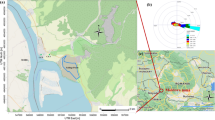Abstract
Frequent dust storms and recent environmental changes were found to affect the human health especially in residents of arid countries. Investigations on the PM2.5 fugitive dust in six Kuwait Governorate areas using dispersion Gaussian plume modeling revealed significant relationship between low rate of pollutant emission, low wind velocity, and stable weather conditions’ matrix causing high rate of dust deposition in summer than in winter. The rate of dust deposition and trace metals levels in PM2.5 were in the sequence of G-VI > G-I > G-II > G-V > G-III > G-IV. Trace metals were observed in the sequence of Al > Fe > Zn > Ni > Pb > Cd irrespective of the Governorate areas and the two seasons. The high rate of dust deposition and trace metals in PM2.5 was reflected by the vast open area, wind velocity, and rapid industrialization besides natural and anthropogenic sources. A combination of air dispersion modeling and nephalometric and gravimetric studies of this kind not only determines the seasonal qualitative and quantitative analyses on the PM2.5 dust deposition besides trace metals apportionment in six Kuwait Governorate areas, but also characterizes air pollution factors that could be used by environmentalist to deduce preventive measures.
Similar content being viewed by others
References
Brown, K. W., Bouhamra, W., Lamoureux, D. P., Evans, J. S., & Koutrakis, P. (2008). Characterization of particulate matter for three sites in Kuwait. Journal of the Air Waste Management Association, 58(8), 994–1003.
Bu-Olayan, A. H., & Thomas, B. V. (2010). Validating trace metals in PM2.5 aerosols from indoor and outdoor polluting premises. American Journal of Environmental Sciences, 6(3), 224–229.
Engelbrecht, J. P., McDonald, E. V., Gillies, J. A., Jayanty, R. K. M., Casuccio, G., & Gertler, A. W. (2009). Characterizing mineral dusts and other aerosols from the Middle East Part 1. Ambient sampling. Inhalation Toxicology, 21(4), 297–326.
Jimenez, V. B., Detres, Y., Armstrong, R. A., & Gioda, A. (2009). Characterization of African dust (PM2.5) across the Atlantic Ocean during AEROSE 2004. Atmospheric Environment, 43(16), 2659–2664.
Joseph, P., Ilhan, O., & Michael, A. (2001). Al and Fe in PM2.5 and PM10 suspended particles in South-Central Florida: The impact of the long range transport of African mineral dust. Water, Air and Soil Pollution, 125, 291–317.
Krolak, E. (2000). Heavy metals in falling dust in eastern Mazowieckie Province. Polish Journal of Environmental Studies, 9(6), 517–522.
Lee, J. A., & Zobeck, T. M. (2002). Proceedings of ICAR5/GCTE-SEN Joint Conference, International Center for arid and semi-arid lands studies. Texas Tech University, Lubbock, Texas, USA, 02-2, p. 347.
Rashed, M. N. (2008). Total and extractable heavy metals in indoor, outdoor and street dust from Aswan City, Egypt. Clean-Soil, Air Water, 36(10–11), 850–857.
Saleh, A., Al-Ruwaih, F., Al-Reda, A., & Gunatilaka, A. (1999). A reconnaissance study of a classic coastal Sabkha in Northern Kuwait, Arabian Gulf. Journal of Arid Environments, 43, 1–19.
Saxton, K., Chandler, D., Stetler, L., Lamb, B., Claiborn, C., & Lee, B. H. (2000). Wind erosion and fugitive dust fluxes on agricultural land in Pacific North West. Transactions of the ASAE, 43, 623–630.
SWOP (South-West Organizing Project) (2009). Basic air pollution model. Arizona State University, Albuquerque, NM, USA. http://www.swop.net/intel/air_model.html. Accessed 24 January 2010.
Tang, H., Al-Ajmi, D., & Shen, X. (2005). Air pollution of PM10 with radionuclide Cs-137 in Kuwait City, Kuwait. Environmental Health Risk III, Book Series: WIT. Transaction of Biomedical Health, 9, 169–177.
Teixeira, E. C., Meira, L., deSantana, E. R. R., & Wiegand, F. (2009). Chemical composition of PM10 and PM2.5 and seasonal variation in South Brazil. Water, Air & Soil Pollution, 199(1–4), 261–275.
USEPA (2010). Fine particles (PM2.5) designations. http://www.Epa.gov/pmdesignations/faq.html. Accessed 2 March 2010.
Wang, H., Zhuang, Y. H., Wang, Y., Sun, Y., Yuan, H., Zhuang, G. S., et al. (2008). Long-term monitoring and source apportionment of PM2.5/PM10 in Beijing, China. Journal of Environmental Science China, 20(11), 1323–1327.
Zobeck, T. M., Gill, T. E., & Popham, T. W. (1999). A two parameter Weibull function to describe airborne particle size distributions. Earth Surface Processes and Landforms, 24, 943–955.
Author information
Authors and Affiliations
Corresponding author
Rights and permissions
About this article
Cite this article
Bu-Olayan, A.H., Thomas, B.V. Dispersion model on PM 2.5 fugitive dust and trace metals levels in Kuwait Governorates. Environ Monit Assess 184, 1731–1737 (2012). https://doi.org/10.1007/s10661-011-2074-y
Received:
Accepted:
Published:
Issue Date:
DOI: https://doi.org/10.1007/s10661-011-2074-y




